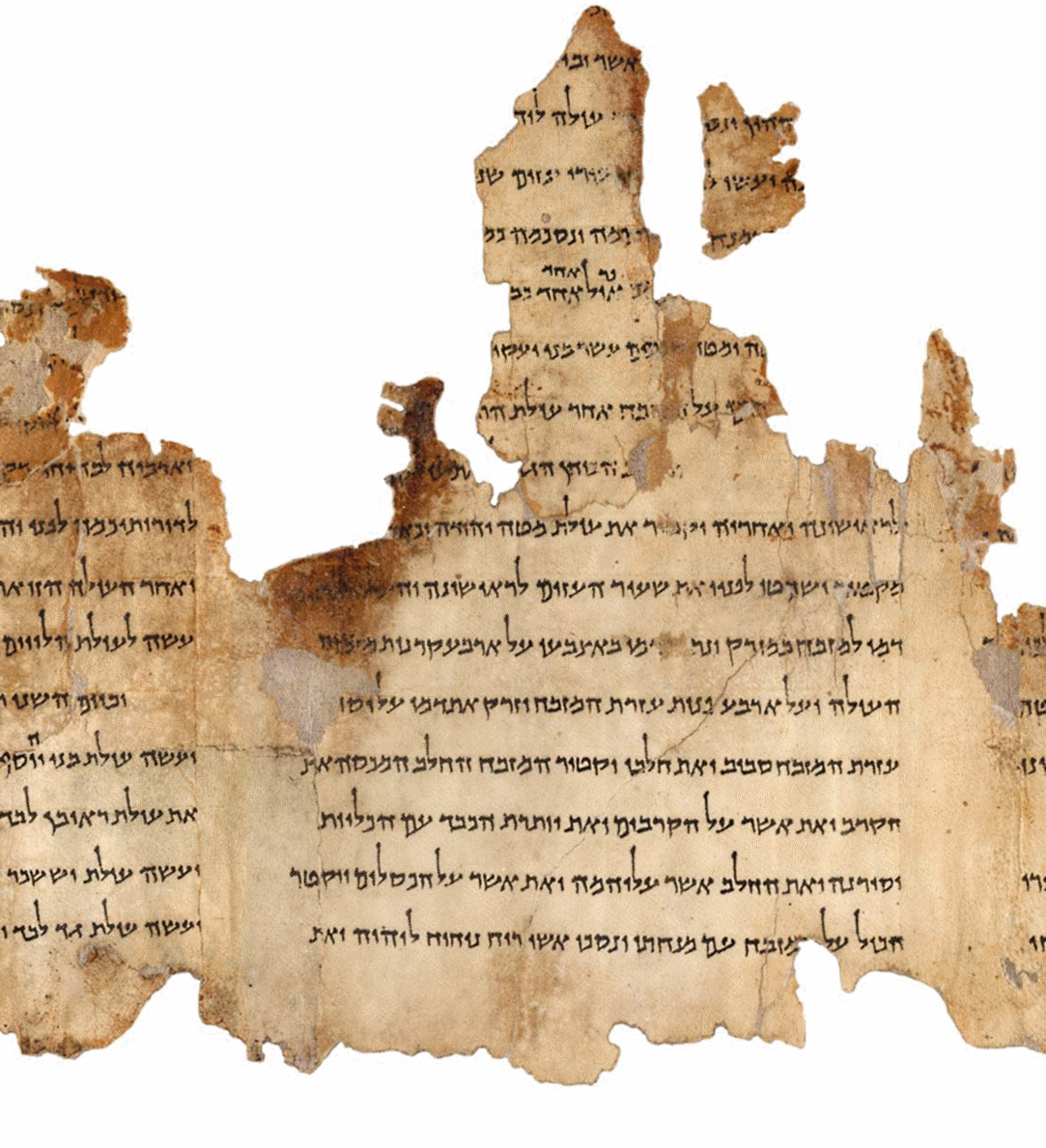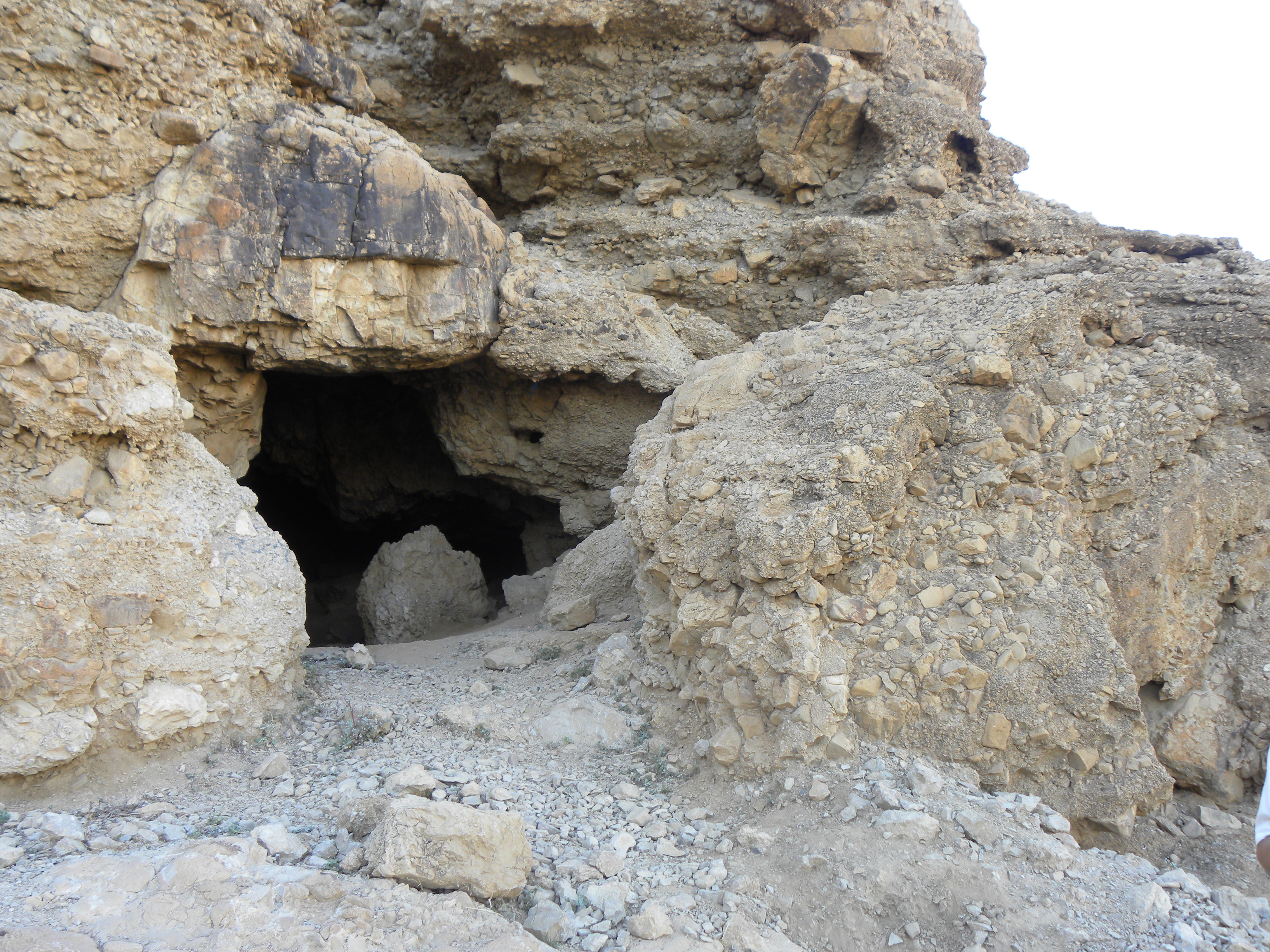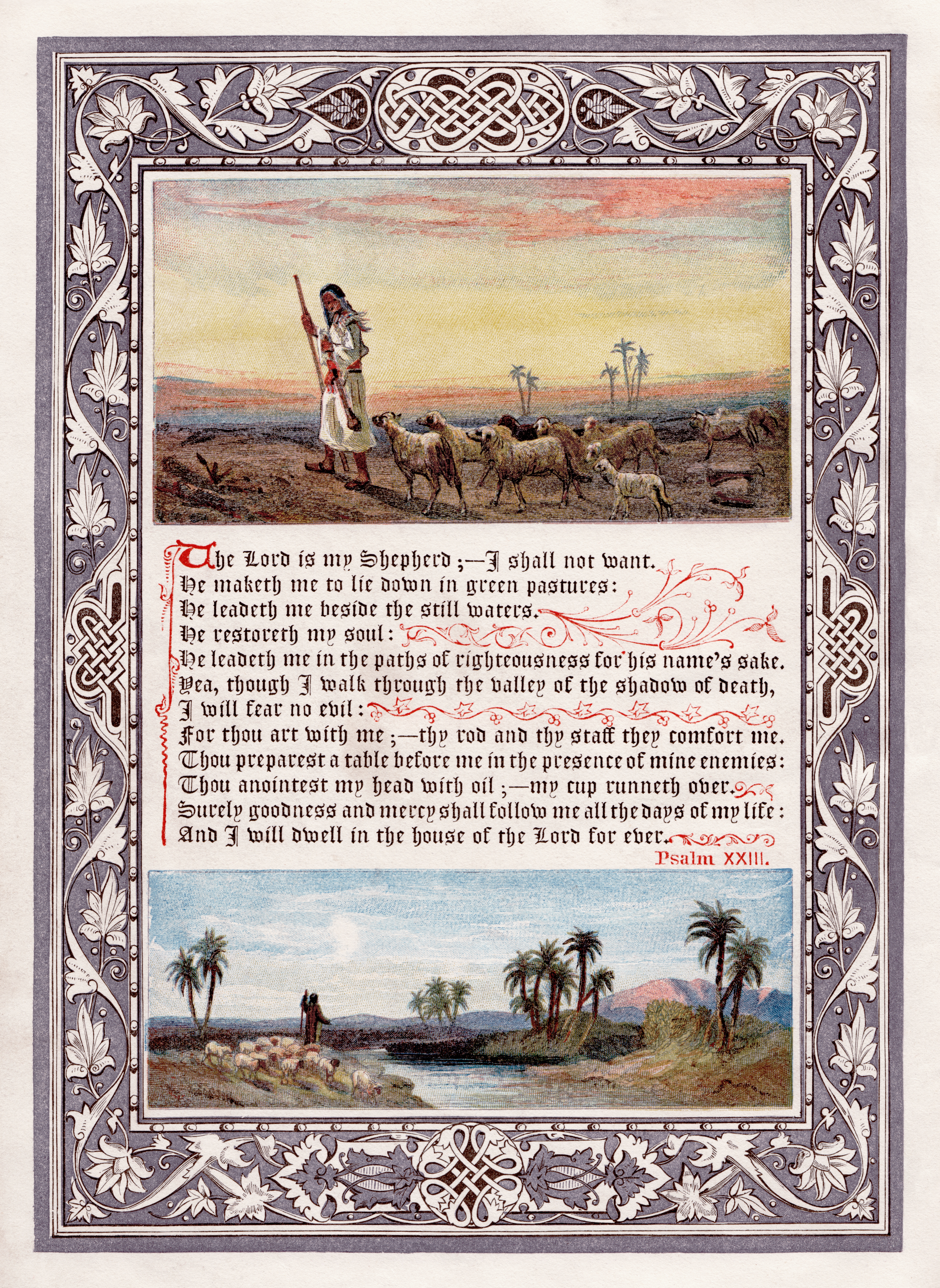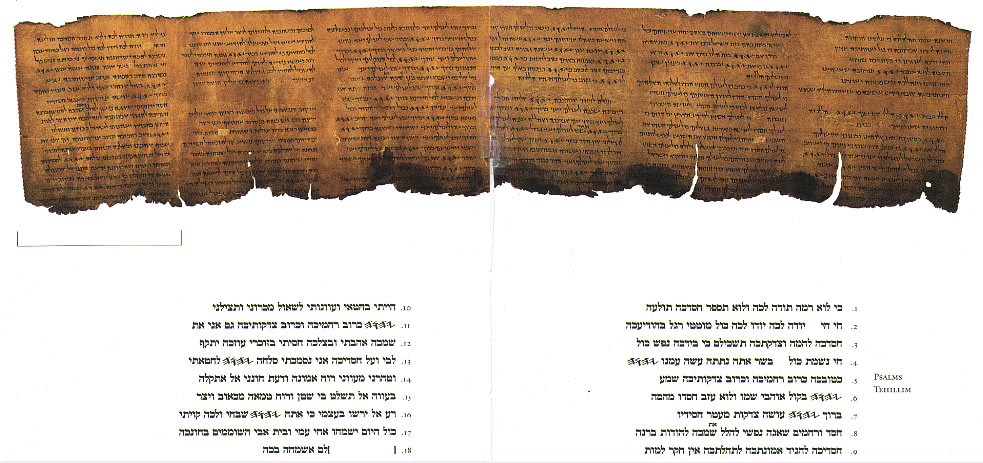|
List Of Manuscripts From Qumran Cave 11
The following is a list of the Dead Sea Scrolls from the cave 11 near Qumran. Description Wadi Qumran Cave 11 was discovered in 1956 and yielded 21 texts of Dead Sea Scrolls, some of which were quite lengthy. The Temple Scroll, so called because more than half of it pertains to the construction of the Temple of Jerusalem, was found in Cave 11, and is by far the longest scroll. It is now 26.7 feet (8.15 m) long. Its original length may have been over 28 feet (8.75 m). The Temple Scroll was regarded by Yigael Yadin as "The Torah According to the Essenes". On the other hand, Hartmut Stegemann, a contemporary and friend of Yadin, believed the scroll was not to be regarded as such, but was a document without exceptional significance. Stegemann notes that it is not mentioned or cited in any known Essene writing. Also in Cave 11, an eschatological fragment about the biblical figure Melchizedek (11Q13) was found. Cave 11 also produced a copy of Jubilees. According ... [...More Info...] [...Related Items...] OR: [Wikipedia] [Google] [Baidu] |
Temple Scroll
The Temple Scroll ( he, מגילת המקדש) is the longest of the Dead Sea Scrolls. Among the discoveries at Qumran it is designated: 11QTemple Scrolla (11Q19 1QTa. It describes a Jewish temple, along with extensive detailed regulations about sacrifices and temple practices. The document is written in the form of a revelation from God to Moses, thereby with the intended meaning that this is the more appropriate temple which was revealed to Moses, and that Moses' instructions were either forgotten or ignored when Solomon built the First Temple in Jerusalem. In other words, in the mind of the Scroll writer, "Solomon should actually have built the First Temple as it is described here in the Temple Scroll". Introduction The Temple Scroll is written in Hebrew in the square Herodian script of the late Second Temple Period, and comprises 65 columns (19 pieces of leather) and is 9 metres in length.Johann Maier, ''The Temple Scroll'' (Sheffield: JSOT Press upplement 341985), p. 1. ... [...More Info...] [...Related Items...] OR: [Wikipedia] [Google] [Baidu] |
Paleo-Hebrew Leviticus Scroll
Paleo-Hebrew Leviticus Scroll, known also as 11QpaleoLev, is an ancient text preserved in one of the Qumran group of caves, and which provides a rare glimpse of the script used formerly by the Holy Land, nation of Israel in writing Torah scrolls during its pre-exilic history. The fragmentary remains of the Torah scroll is written in the Paleo-Hebrew script and was found stashed away in cave no. 11 at Qumran, showing a portion of Book of Leviticus, Leviticus. The scroll is thought to have been penned by the scribe between the late 2nd-century BCE to early 1st-century BCE, while others place its writing in the 1st-century CE. The paleo-Hebrew Leviticus Scroll, although many centuries more recent than the well-known earlier ancient paleo-Hebrew epigraphic materials, such as the Siloam inscription, Royal Steward inscription from Siloam, Jerusalem (eighth century BCE), now in the İstanbul Archaeology Museums, Museum of the Ancient Orient, Istanbul, and the Phoenician inscription on t ... [...More Info...] [...Related Items...] OR: [Wikipedia] [Google] [Baidu] |
Psalm 133
Psalm 133 is the 133rd psalm of the Book of Psalms, beginning in English in the King James Version: "Behold, how good and how pleasant it is for brethren to dwell together in unity". In Latin, it is known as "Ecce quam bonum". The psalm is one of the fifteen Song of Ascents, Songs of Ascents (''Shir Hama'alot''), and one of the three Songs of Ascents consisting of only three verses. In the slightly different numbering system used in the Greek Septuagint version of the Bible and in the Latin Vulgate, this psalm is Psalm 132. The psalm forms a regular part of Jewish, Catholic Church, Catholic, Lutheranism, Lutheran, Anglicanism, Anglican and other Protestant liturgies. It has been set to music often, notably by Heinrich Schütz, Friedrich Kiel, and as the conclusion of Leonard Bernstein's ''Chichester Psalms''. Addressing the topic of unity, the beginning of the psalm has been chosen as a motto by universities, as well as a symbol of brotherhood by freemasonry. Background Psalm 133 ... [...More Info...] [...Related Items...] OR: [Wikipedia] [Google] [Baidu] |
Psalm 119
Psalm 119 is the 119th psalm of the Book of Psalms, beginning in the English of the King James Version: "Blessed are the undefiled in the way, who walk in the law of the Lord". The Book of Psalms is in the third section of the Hebrew Bible, the ''Khetuvim'', and a book of the Christian Old Testament. The psalm, which is anonymous, is referred to in Hebrew by its opening words, "''Ashrei temimei derech''" ("happy are those whose way is perfect"). In Latin, it is known as "Beati inmaculati in via qui ambulant in lege Domini". The psalm is a hymn psalm and an acrostic poem, in which each set of eight verses begins with a letter of the Hebrew alphabet. The theme of the verses is the prayer of one who delights in and lives by the Torah, the sacred law. Psalms 1, 19 and this psalm may be referred to as "the psalms of the Law". Kirkpatrick, A.Cambridge Bible for Schools and Collegeson Psalm 119, accessed 29 May 2022 In the slightly different numbering system used in the Greek Septuag ... [...More Info...] [...Related Items...] OR: [Wikipedia] [Google] [Baidu] |
Psalm 118
Psalm 118 is the 118th psalm of the Book of Psalms, beginning in the English of the King James Version: "O give thanks unto the LORD; for he is good: because his mercy endureth for ever." The Book of Psalms is part of the third section of the Hebrew Bible, and a book of the Christian Old Testament. In the slightly different numbering system used in the Greek Septuagint and Latin Vulgate translations of the Bible, this psalm is Psalm 117. In Latin, it is known as "Confitemini Domino quoniam bonus quoniam in saeculum misericordia eius". Its themes are thanksgiving to God and reliance on God rather than on human strength. The psalm forms a regular part of Jewish, Catholic, Eastern Orthodox, Lutheran, Anglican and other Protestant liturgies. Text Hebrew Bible version Following is the Hebrew text of Psalm 118: King James Version # O give thanks unto the LORD; for he is good: because his mercy endureth for ever. # Let Israel now say, that his mercy endureth for ever. # Let t ... [...More Info...] [...Related Items...] OR: [Wikipedia] [Google] [Baidu] |
Psalm 109
Psalm 109 is a psalm in the Book of Psalms. In the slightly different numbering system used in the Greek Septuagint version of the Bible and in the Latin Vulgate, this psalm is Psalm 108. It is attributed to King David and noted for containing some of the most severe curses in the Bible, such as verses 12 and 13. It has traditionally been called the "Judas Psalm" or "Iscariot Psalm" for an interpretation relating verse 8 to Judas Iscariot's punishment as noted in the New Testament. The psalm's Latin title is ''Deus, laudem'', from its opening words, ''Deus, laudem meam ne tacueris'' ("My God, whom I praise, do not remain silent" in the New International Version). Analysis The New Oxford Annotated Bible titles this psalm "Prayer for deliverance from enemies", as one of the Imprecatory Psalms against deceitful foes. It starts with the psalmist's plea in verses 1–5, followed by an extensive imprecation (verses 6–19, concluded or summed up in verse 20). The renewed plead ... [...More Info...] [...Related Items...] OR: [Wikipedia] [Google] [Baidu] |
Psalm 78
Psalm 78 is the 78th psalm in the biblical Book of Psalms. It is one of the 12 Psalms of Asaph and is described as a "maskil" or "contemplation". It is the second-longest Psalm, with 72 verses (Psalm 119 has 176 verses), and the first of the three great history psalms (the others being Psalms 105 and 106). The New American Bible, Revised Edition entitles it "a new beginning in Zion and David". In the slightly different numbering system used in the Greek Septuagint and Latin Vulgate translations of the Bible, this psalm is Psalm 77. Uses Judaism *This psalm is recited on the third through sixth days of Passover in some traditions. *Verse 36-37 are found in the Foundation of Repentance recited on the eve of Rosh Hashanah. *Verse 38 (''V'hu Rachum'') is the first verse of a paragraph by the same name in Pesukei Dezimra, is the seventeenth verse of Yehi Kivod in Pesukei Dezimra, is the opening verse of the long Tachanun recited on Mondays and Thursdays, is found in Uva Letzion, ... [...More Info...] [...Related Items...] OR: [Wikipedia] [Google] [Baidu] |
Psalm 77
Psalm 77 (Greek numbering: Psalm 76) is the 77th psalm in the biblical Book of Psalms. In the slightly different numbering system of the Greek Septuagint version of the bible, and in its Latin translation in the Vulgate, this psalm is ''Psalm 76''. Content The psalm begins with a cry of distress: the psalmist has been experiencing profound difficulties, and his cries to God appear to have been ignored; only his memories of the past seem to bring anything even resembling joy. However, the psalmist then remembers God's integrity and realises that the failure of his hopes is the result of misplaced expectations of God's actions, rather than God's failure to act. Recalling God's actions in the past and his rule even over the natural world, he concludes with praise of "the God who performs miracles" (verse 14).Spurgeon, Charles Haddon, The Treasury of David: Psalm 77'', digital edition, 2011. Accessed 2013-11-08. Interpretations Coming from an evangelical Protestant perspective, Ch ... [...More Info...] [...Related Items...] OR: [Wikipedia] [Google] [Baidu] |
Psalms
The Book of Psalms ( or ; he, תְּהִלִּים, , lit. "praises"), also known as the Psalms, or the Psalter, is the first book of the ("Writings"), the third section of the Tanakh, and a book of the Old Testament. The title is derived from the Greek translation, (), meaning "instrumental music" and, by extension, "the words accompanying the music". The book is an anthology of individual Hebrew religious hymns, with 150 in the Jewish and Western Christian tradition and more in the Eastern Christian churches. Many are linked to the name of David, but modern mainstream scholarship rejects his authorship, instead attributing the composition of the psalms to various authors writing between the 9th and 5th centuries BC. In the Quran, the Arabic word ‘Zabur’ is used for the Psalms of David in the Hebrew Bible. Structure Benedictions The Book of Psalms is divided into five sections, each closing with a doxology (i.e., a benediction). These divisions were probably intro ... [...More Info...] [...Related Items...] OR: [Wikipedia] [Google] [Baidu] |
Book Of Psalms
The Book of Psalms ( or ; he, תְּהִלִּים, , lit. "praises"), also known as the Psalms, or the Psalter, is the first book of the ("Writings"), the third section of the Tanakh, and a book of the Old Testament. The title is derived from the Greek translation, (), meaning "instrumental music" and, by extension, "the words accompanying the music". The book is an anthology of individual Hebrew religious hymns, with 150 in the Jewish and Western Christian tradition and more in the Eastern Christian churches. Many are linked to the name of David, but modern mainstream scholarship rejects his authorship, instead attributing the composition of the psalms to various authors writing between the 9th and 5th centuries BC. In the Quran, the Arabic word ‘Zabur’ is used for the Psalms of David in the Hebrew Bible. Structure Benedictions The Book of Psalms is divided into five sections, each closing with a doxology (i.e., a benediction). These divisions were probably introdu ... [...More Info...] [...Related Items...] OR: [Wikipedia] [Google] [Baidu] |
The Great Psalms Scroll
The Great Psalms Scroll, also referred to as 11Q5, is the most substantial and well preserved Dead Sea Scrolls Psalms manuscript of the thirty-seven discovered in the Qumran caves, six of which were discovered in Cave 11. Description The scroll was discovered in February of the year 1956, ten years after the initial discovery of the scrolls. It was purchased by The Palestine Archaeological Museum located in Jerusalem and first unrolled in November 1961. Four fragments of this scroll were later purchased by the same museum. The scroll's physical make up is that of dark yellow animal hide and is a little less than 1 mm thick. The primary body of the manuscript consists of “5 sheets of leather, still sewn together”, and is 4.253 meters in length. It is estimated to have been copied anywhere from 30-50 AD, and is written in Biblical style Hebrew. When rolled out, it forms a slight arc, and the top part is clean and well kept, while the bottom is decomposing significantly. It ... [...More Info...] [...Related Items...] OR: [Wikipedia] [Google] [Baidu] |
Book Of Ezekiel
The Book of Ezekiel is the third of the Latter Prophets in the Tanakh and one of the major prophetic books, following Isaiah and Jeremiah. According to the book itself, it records six visions of the prophet Ezekiel, exiled in Babylon, during the 22 years from 593 to 571 BCE, although it is the product of a long and complex history and does not necessarily preserve the very words of the prophet. The visions, and the book, are structured around three themes: (1) Judgment on Israel (chapters 1–24); (2) Judgment on the nations (chapters 25–32); and (3) Future blessings for Israel (chapters 33–48). Its themes include the concepts of the presence of God, purity, Israel as a divine community, and individual responsibility to God. Its later influence has included the development of mystical and apocalyptic traditions in Second Temple and Judaism and Christianity. Structure Ezekiel has the broad three-fold structure found in a number of the prophetic books: oracles of wo ... [...More Info...] [...Related Items...] OR: [Wikipedia] [Google] [Baidu] |








